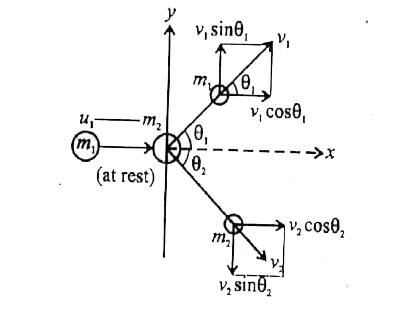If a particle elastically collides obliquely with a particle of same mass at rest then show that they move perpendicular to each other after collision in two dimension. Solution in Tamil

After the collision, the rectangular components of the momentum of m1 are
(i) m1v1cosθ, along positive x axis
(ii) m1v1sinθ, along positive y axis
After the collision, the rectangular components of the momentum of m2 are
(i) m2v2cosθ, along positive x axis
m2v2sinθ, along positive y axis
Applying the law of conservation of momentum along x axis we get,
m1u1=m1v1cosθ1+m2v2cosθ2 ...(1)
The initial momentum of m1 or m2 along y axis is zero. Applying the principle of conservation of momentum along y axis we get,
0=m1θsinθ1+m2v2sinθ2....(2)
In this problem, a particle elastically collides obliquely with a particle of same mass at rest. So the two particles are identical.
∴m1=m2=m (say)
By conservation of kinetic energy for elastic collision we get,
12mu21=12mv21+12mv22[∵u2=0]
Dividing by 12m2 we get
∴u1=v21+v22 ...(3)
By conservation of linear momentum we get
m→u1=m→v1+m→v2
Dividing by m we get
→u1=→v1+→v2 ...(4)
Then →u1.→u1=(→v1+→v2)(→v1+→v2)
=→v1.→v1+→v1.→v2+→v2.→v1+→v2.→v2
or u21=v21+v22+2→v1→v2 ...(5)
But from (3)
v21+v22=u21
∴ Equation (5) becomes
u21=u21+2→v1→v2
∴→v1→v2=0
This shows that the angle between →v1and→v2 is 90∘.
Hence two identical particles move perpendicular to each other after collision in two dimensions.
Topper's Solved these Questions
- BOOK - PREMIERS PUBLISHERSCHAPTER - WORK, ENERGY AND POWER EXERCISE - CONCEPTUAL QUESTIONS34videos
WORK, ENERGY AND POWER
- BOOK - PREMIERS PUBLISHERSCHAPTER - WORK, ENERGY AND POWER EXERCISE - MULTIPLE CHOICE QUESTIONS (OTHER IMPORTANT QUESTIONS & ANSWERS)124videos
WORK, ENERGY AND POWER
- BOOK - PREMIERS PUBLISHERSCHAPTER - WORK, ENERGY AND POWER EXERCISE - LONG ANSWER QUESTIONS38videos
WORK, ENERGY AND POWER
- BOOK - PREMIERS PUBLISHERSCHAPTER - WAVESEXERCISE - OTHER IMPORTANT & QUESTIONS ANSWERS ( NUMERICAL PROBLEMS. )48videos
WAVES
Similar Questions
A spring which is initially in un-streatched condition, is first stretched by a length x and again by a further length x. The work done in the first case W1 is one third of the work done in second case W2. True of false ?
02:00View SolutionA particle is acted upon by a force of constant magnitude which is always perpendicular to the velocity of the particle, the motion of the particles takes place in a plane. It follows that:
01:50View SolutionExplain with graphs the difference between work done by a constant force and by a variable force.
07:37View SolutionThe equation of a wave is,
y(x,t)=0.05sin[π2(10x−40t)−π4]m Find,
The wavelength, the frequency and the wave velocity.
(ii) The particle velocity and acceleration at x=0.5 m and t=0.05 s.15:10View SolutionA particle A suffers an oblique elastic collision particle B that is at rest initially. If their masses with a are the same, then after the collision
View SolutionIn a perfectly elastic collision in two dimensions between two particles of ………………….mass,the two particles move at …………………..to each other.
View SolutionIf a particle elastically collides obliquely with a particle of same mass at rest then show that they move perpendicular to each other after collision in two dimension.
View Solutionएक गतिशील कण समान द्रव्यमान के दूसरे पूर्णतः कण से टक्कर करता है। टक्कर सम्मुख नहीं है परन्तु पूर्णतः प्रत्यास्थ है सिद्ध करिये की टक्कर के पश्चात ये कण परस्पर लंबवत गति करेंगे ।
04:20View SolutionProve that in case of oblique elastic collision of two particles of equal mass if one is at rest, the recoiling particles always move off at right angles to each other.
02:55View SolutionProve that in case of oblique elastic collision of two particles of equal mass if one is at rest, the recoiling particles always move off at right angles to each other.
View SolutionProve that in case of oblique elastic collision of two particles of equal mass if one is at rest, the recoiling particles always move off at right angles to each other.
View SolutionTwo bodies of equal masses moving mutually at right angles to each other, collide elastically. After the collision, the particles will move in
View SolutionA particle of mass m moving with velocity u collides elastically with a particle of mass 3m at rest. After collision the heavier particle moves with velocity.
02:14View SolutionProve that in case of oblique elastic collision of two particles of equal mass if one is at rest, the recoiling particles always move off at right angles to each other
02:16View SolutionTwo bodies of equal masses moving mutually at right angles to each other, collide elastically. After the collision, the particles will move in
04:40View Solution
